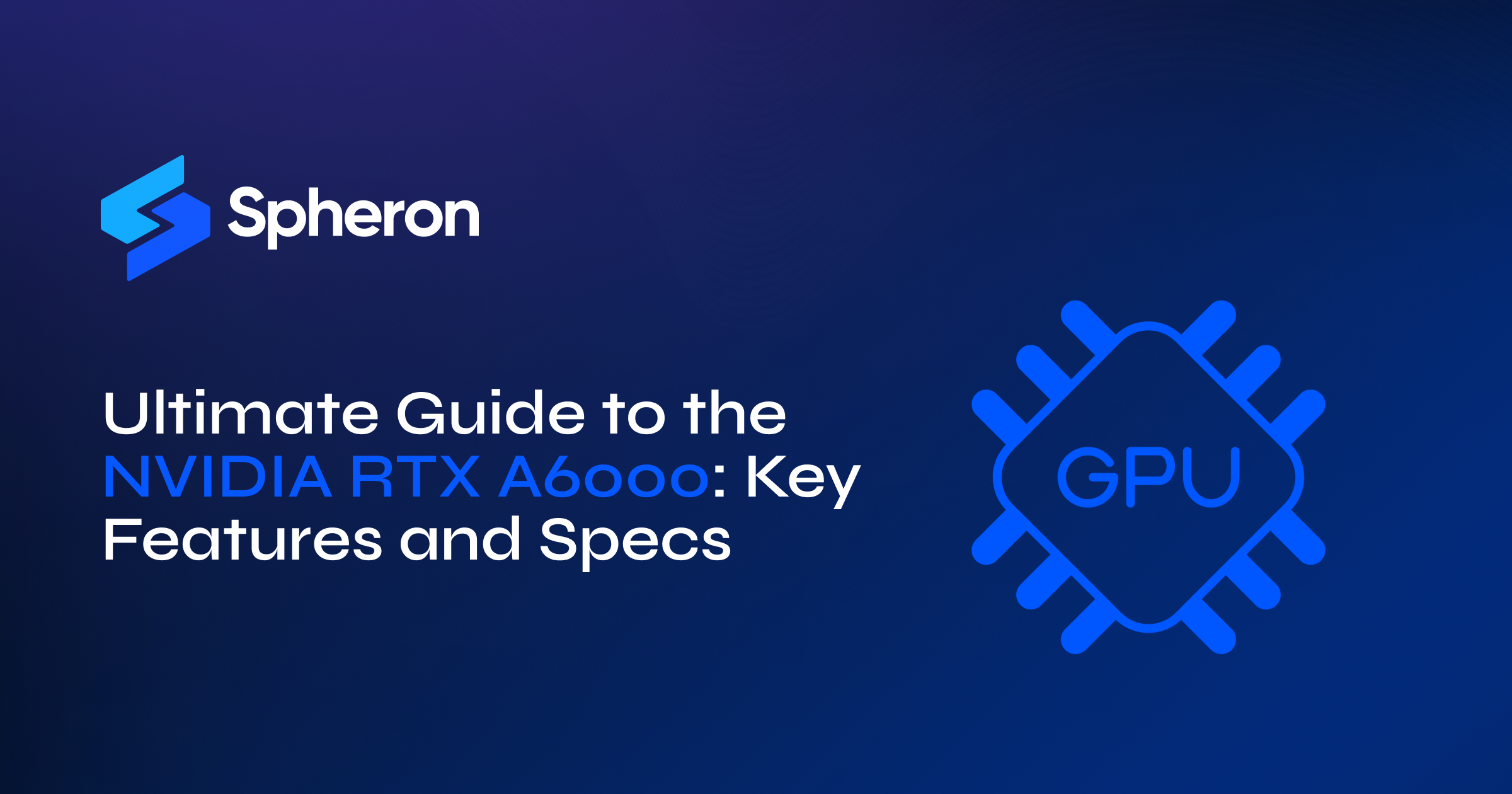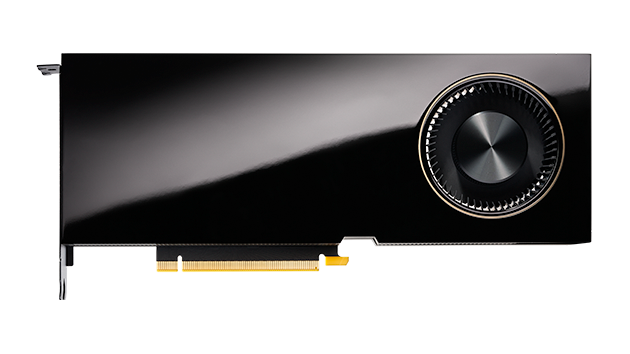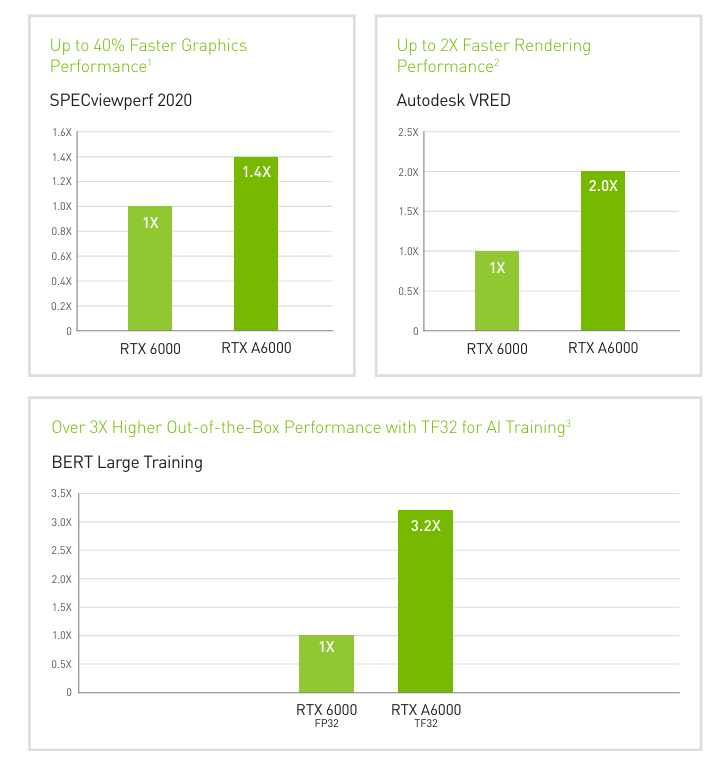Ultimate Guide to the NVIDIA RTX A6000: Key Features and Specs
 Spheron Network
Spheron Network
The NVIDIA RTX A6000 is a powerful GPU based on the Ampere architecture, offering impressive capabilities for handling memory-intensive tasks in various applications. As a cost-effective solution for high-performance computing (HPC) enthusiasts, this GPU distinguishes itself from other models like the NVIDIA RTX A5000. In this evaluation, we delve into the specifications, pricing, and potential use cases of the NVIDIA RTX A6000 while addressing frequently asked questions to assist you in deciding whether this GPU suits your resource-demanding workloads.
Key Specifications of the NVIDIA A6000
Sharing the same GA102 architecture found in NVIDIA's Ampere GPU lineup, the NVIDIA A6000 boasts several advanced features tailored explicitly for enhanced computational capabilities. These include:
10,752 CUDA cores dedicated to general-purpose parallel computing
336 third-generation Tensor Cores optimized for artificial intelligence (AI) acceleration
84 second-generation RT Cores specialized for real-time ray tracing
A significant advantage of the NVIDIA RTX A6000 lies in its ability to perform single-precision floating-point (FP32) operations at double speed, accompanied by superior energy efficiency than the A5000 counterpart. Delivering 38.71 TFLOPS in FP32 performance, the A6000 outperforms the A5000, which offers 27.77 TFLOPS. This results in noticeably faster progressions in graphical and simulated workflows—complex 3D computer-aided design (CAD) and engineering analysis (CAE) projects being prime examples.
Equipped with cutting-edge second-generation RT Cores, users benefit from nearly doubled throughput compared to previous generations, facilitating simultaneous ray tracing, shading, and denoising. Such enhancements are particularly useful for producing realistic renderings in film production, conducting thorough assessments within architectural designs, or developing detailed virtual prototypes. These updated RT Cores substantially reduce computation times associated with ray-traced motion blur, generating more precise outcomes.
Furthermore, the NVIDIA RTX A6000 incorporates next-level third-generation Tensor Cores, introducing novel Tensor Float 32 (TF32) precision. With this innovation, developers experience approximately fivefold increases in training when compared to Turing-based GPUs, including the Quadro RTX 6000 and RTX 8000 models. No coding adjustments are required to harness these benefits, making deployment seamless for those focused on AI and data science model training.
Additional noteworthy features of the NVIDIA RTX A6000 comprise 48 gigabytes (GB) of super-fast GDDR6 memory expandable to 96 GB using NVLink technology. Consequently, users obtain ample memory resources to manage extensive datasets and taxing workloads typically encountered during data science investigations and simulations. Furthermore, the elevated GPU-to-GPU interconnect bandwidth enables the construction of a unified, scalable memory space capable of accommodating expansive datasets, ultimately improving overall performance across both graphic and computational undertakings.
NVIDIA A6000 Specifications Chart
| Feature | Specification |
| GPU Memory | 48 GB GDDR6 |
| Memory Interface | 384-bit |
| Memory Bandwidth | 768 GB/s |
| Error-Correcting Code (ECC) | Yes |
| CUDA Cores | 10,752 |
| Tensor Cores (Third-Generation) | 336 |
| RT Cores (Second-Generation) | 84 |
| Single-Precision Performance | 38.7 TFLOPS |
| RT Core Performance | 75.6 TFLOPS |
| Tensor Performance | 309.7 TFLOPS |
| NVLink | Connects two NVIDIA RTX A6000 GPUs |
| NVLink Bandwidth | 112.5 GB/s (bidirectional) |
| System Interface | PCI Express 4.0 x16 |
| Power Consumption | Total board power: 300 W |
| Thermal Solution | Active |
| Form Factor | 4.4” H x 10.5” L, dual slot, full height |
| Display Connectors | 4x DisplayPort 1.4a |
| Max Simultaneous Displays | 4x 4096 x 2160 @ 120 Hz<br>4x 5120 x 2880 @ 60 Hz<br>2x 7680 x 4320 @ 60 Hz |
| Power Connector | 1x 8-pin CPU |
| Encode/Decode Engines | 1x encode, 2x decode (+AV1 decode) |
| VR Ready | Yes |
| vGPU Software Support | NVIDIA vPC/vApps<br>NVIDIA RTX Virtual Workstation<br>NVIDIA Virtual Compute Server |
| vGPU Profiles Supported | 1 GB, 2 GB, 3 GB, 4 GB, 6 GB, 8 GB, 12 GB, 16 GB, 24 GB, 48 GB |
| Graphics APIs | DirectX 12.0710, Shader Model 5.1710, OpenGL 4.6811, Vulkan 1.1811 |
| Compute APIs | CUDA, DirectCompute, OpenCL™ |
Supported Resolutions and Refresh Rates:
| Number of Screens | Resolution(s) | Refresh Rate(s) |
| 4 | 4096 x 2160 | 120 Hz |
| 4 | 5120 x 2880 | 60 Hz |
| 2 | 7680 x 4320 | 60 Hz |
Employing NVIDIA's vGPU software on the NVIDIA RTX A6000 converts a solitary workstation into numerous potent virtual workstation instances. This capability empowers distant users to access shared high-performance resources flexibly and efficiently.
Enhanced Performance for Professionals
The NVIDIA RTX™ A6000, based on the NVIDIA Ampere architecture, provides designers, engineers, scientists, and artists with the power needed to handle the most demanding graphics and compute-intensive tasks. Featuring the latest RT Cores, Tensor Cores, and CUDA® cores, the RTX A6000 offers unmatched performance in rendering, AI, graphics, and computing. Certified by a wide range of professional applications, rigorously tested by leading independent software vendors (ISVs) and workstation manufacturers, and supported by a global team of specialists, NVIDIA RTX is the preferred visual computing solution for challenging enterprise deployments.
Use Cases and Applications of the NVIDIA A6000
Beyond its primary design for professional applications, the NVIDIA A6000 also proves to be highly effective in various other scenarios:
Gaming Despite its focus on professional tasks, the A6000 delivers outstanding performance in high-end gaming:
4K Resolution and Ray Tracing: Gamers experience exceptional performance at 4K resolution with fluid gameplay and enhanced visuals. The A6000’s second-generation RT Cores offer superior ray tracing capabilities, providing realistic lighting, shadows, and reflections. Popular titles like Call of Duty and Battlefield V run seamlessly at maximum settings.
DLSS Technology: The A6000 supports NVIDIA's DLSS technology, which leverages AI to upscale lower resolutions to 4K. This enhances frame rates and image quality, making gaming more immersive and visually impressive without sacrificing performance.
Professional Applications The A6000 brings significant advancements to various professional fields:
Architecture, Engineering, and Media Production: With its large memory capacity and processing power, the A6000 facilitates faster rendering and more intricate simulations. Software like Blender, SolidWorks, and DaVinci Resolve benefit greatly from the A6000’s capabilities, enhancing performance in high-resolution video editing, 3D rendering, and scientific simulations.
Handling Large Datasets: The A6000's ability to manage large datasets and complex models makes it indispensable for professionals. It excels in high-resolution video editing, 3D rendering, and scientific simulations, providing efficiency and speed for demanding projects.
VR and AR The A6000 are ideally suited for virtual and augmented reality applications:
Smooth Performance: The A6000's high frame rates and low latency ensure a seamless VR and AR experience. This is crucial for developers creating immersive experiences and simulations, improving the realism and interactivity of these applications.
Training Simulations and Medical Applications: The A6000’s performance in VR and AR makes it suitable for training simulations, medical applications, and virtual prototyping. Its powerful rendering capabilities support the development of highly detailed and interactive virtual environments.
Additional Applications
Scientific Research: The A6000 is perfect for scientific research that demands high computational power and extensive memory capacity. It supports complex simulations in physics, chemistry, and biology, allowing researchers to visualize and analyze data more effectively.
Artificial Intelligence and Deep Learning: Equipped with third-generation Tensor Cores and support for TF32 precision, the A6000 excels in AI and deep learning tasks. It accelerates model training and inference, making it a potent tool for AI researchers and developers.
Content Creation: The A6000 supports a range of content creation applications, providing the performance needed for tasks such as video editing, animation, and graphic design. Its advanced features enable creators to work efficiently with high-resolution content and complex effects.
Subscribe to my newsletter
Read articles from Spheron Network directly inside your inbox. Subscribe to the newsletter, and don't miss out.
Written by

Spheron Network
Spheron Network
On-demand DePIN for GPU Compute

